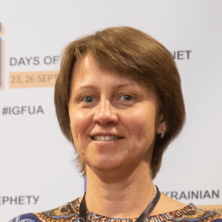Ukraine’s international broadcasting system was established in 2015 following the adoption of the law On the International Broadcasting System of Ukraine. It aimed to provide foreigners and the Ukrainian diaspora with objective information about events in Ukraine. Specifically, the Government created information channel UA|TV that broadcast internationally. Its main language was English but the channel also produced programs in Russian, Ukrainian, Arabic and Crimean Tatar.
However, in 2019, UA|TV international broadcasting channel’s concept underwent a change. On the basis of the International Broadcasting Multimedia Platform of Ukraine (IBMPU), the Government created the state channel “Dom” to broadcast to the temporarily occupied territories of Crimea and Donbas. The channel’s main language de jure became Ukrainian. The English-language editorial team was disbanded, and now the channel’s broadcasts are mainly in Russian. According to the new concept, the channel became entertainment-oriented and started working for the occupied territories, the localities in Ukraine adjacent to them, and Ukrainian populated places bordering on the Russian Federation.
In June 2020, the President signed a law that legally formalized the new approach to international broadcasting.
Key facts and dates
At the time of its creation in 2015, UA|TV was regarded as Ukraine’s tool for responding to information aggression on the part of the Russian Federation. It was modeled after such international broadcasters as the BBC, DW, Russia Today, Al-Jazeera, etc. to create a positive image of Ukraine and keep its international audience informed about the events in Ukraine.
International broadcasting needed a well-developed infrastructure – creating foreign language editorial teams (English, Russian, Crimean Tatar, Arabic) and expanding cable broadcasting abroad. The funding was set at no less than 0.06% of the state budget general fund spending for the previous year. However, this figure was achieved only in 2018, with the allocation of UAH 482 million (Fig. 1).
Figure 1. Spending on international broadcasting, actual versus planned.

Source: State Statistics Service
Although the funding of Ukraine’s international broadcasting was incomparable to that of Russia Today, it successfully expanded its broadcasting to 19 countries over four years, opening English, Crimean Tatar and Arabic language newsrooms.
In 2019, the Ministry of Information Policy merged with the Ministry of Culture, and the Ministry for Youth and Sports. The new Minister, Volodymyr Borodianskyi, began to promote a new vision of Ukraine’s international broadcasting, the essence of which was that international broadcasting should aim to expand into the temporarily occupied territories. He voiced the idea of establishing two channels – one for entertainment and one for information.
In March 2020, the UATV channel was renamed to entertainment channel “Dom”, ceasing to broadcast internationally.
On May 19, 2020, amendments to the law on international broadcasting were adopted. The changes legally formalized “Dom” channel’s operations instead of UATV and other broadcasting projects in the temporarily occupied territories, within the legislative framework of “state international broadcasting”.
Short description of the changes
Content of the International Broadcasting Multimedia Platform can now be produced not in English and other languages, but in Ukrainian and other languages. The requirement for 50% of programs in English was lifted.The law obliges the broadcaster to coordinate its program policy with an authorized body. At the time of the channel’s creation, it was the Ministry of Culture, Youth and Sports. Today, the process of transferring this function to the Ministry of Reintegration is underway.
The law expands the list of territories where broadcasting is possible. In addition to other countries, it is now allowed to “broadcast in the temporarily occupied territories of Donetsk and Luhansk Oblasts, the Autonomous Republic of Crimea and the city of Sevastopol, in the areas of Ukraine bordering on the temporarily occupied territories of Donetsk and Luhansk Oblasts, the Autonomous Republic of Crimea and the city of Sevastopol, as well as in Ukraine’s border areas adjacent to the territory of the aggressor state or other countries’ territories.”
Main innovations:
- possibility to use Ukrainian or Russian as the main language instead of English;
- possibility to broadcast not only in the temporarily occupied territories, but also in the territories controlled by Ukraine that border on the TOT and the Russian Federation.
Strengths:
- Creating state broadcasting for the temporarily occupied territories;
- Targeting the audience living on the territory of Ukraine bordering on the occupied territories, Russia and Belarus.
Weaknesses:
- The changes contradict the concept of international broadcasting, steering funding to broadcast on the territory of Ukraine.
The preamble of the Law reads as follows: “This Law creates a legal basis for the organization and defines the tasks and functions of the state international broadcasting of Ukraine, the principles of state international broadcasting in order to protect Ukraine’s national interests abroad, create and maintain a positive image of Ukraine globally...” However, the changes actually make it possible to allocate state budget funds not for international broadcasting to create a positive image globally, as originally planned, but for broadcasting within Ukraine (Dom TV channel in lieu of UATV). Besides,
- State agency control over the broadcaster’s editorial policy was strengthened, which contradicts the principles of independent media.
- The changes make it possible to completely cease production of content in foreign languages (including English) for the international community.
The changes put in place are part of the strategy on information reintegration of Crimea and Donbas creating opportunities for active Ukrainian TV broadcasting in the temporarily occupied territories. In the future, developing the TV project “Dom” may slightly increase the share of Ukrainian audiovisual content consumption in the TOT.
Normally, in a democracy, only that international broadcasting is owned by the state which is available exclusively abroad. Private or public broadcasters work for the domestic audience. The occupied territories, the territories bordering on the TOT and the aggressor country are an exception for Ukraine today, since they are influenced by broadcasting from the Russian Federation. Broadcasting there is not economically profitable for private TV channels, and establishing a state channel is, therefore, necessary.
The main problem with the changes in question is that they abolish Ukraine’s international broadcasting in foreign languages on the model of the BBC, DW, Russia Today or Al-Jazeera. Simply put, Ukraine’s international broadcasts will cease to be created for viewers from other countries.
And yet, such changes clearly demonstrate that the Government’s priority is the temporarily occupied territories.
Attention
The authors do not work for, consult to, own shares in or receive funding from any company or organization that would benefit from this article, and have no relevant affiliations




